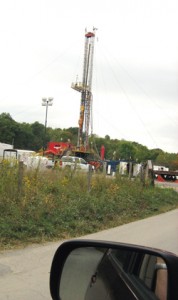
Infrastructure, including stormwater systems, roads, bridges, water treatment plants, and locks and dams, is aging across the nation. Federal and state programs are having trouble keeping up with necessary maintenance and modernization; regional agencies, such as the 10-county Southwestern Pennsylvania Commission, are a sensible solution since ailing infrastructure often causes regional problems (ex. inadequate waste water treatment upstream causes drinking water treatment problems downstream).
With gas drilling activity putting additional strain on infrastructure, it only makes sense for some of the increased state revenue from natural gas production in the Marcellus Shale region to be put toward improvements in roads, water treatment, and other public projects. Taxes and fees aside, Pennsylvania has been grappling with the question of how to handle royalty payments that are starting to roll in from leases on state parks and forests. While the governor and others are eying the money for various projects, the U.S. Department of the Interior is scrutinizing whether any of the 175 gas wells on public lands in Pennsylvania are even legal. According to a 1964 federal conservation law, land purchased using money from the Land and Conservation Fund can not be converted to non-recreation use (i.e. a well pad) without prior approval by the National Park Service. Such approval was never requested nor obtained. Additionally, if such conversions were made, Pennsylvania would have to “buy land of at least equal value to compensate, and…use any revenue from leases or royalties…for conservation and recreation purposes only.” (Read the full article here…) The Conservation Fund lands issue also applies to West Virginia.
Citizens for Pennsylvania’s Future, a statewide environmental group, is taking a different approach to protecting public lands: last week they launched a campaign asking natural gas companies to voluntarily pledge not to drill in the state’s parks. Rather, they ask that the gas resources underlying public land be tapped into using horizontal drilling, with a 300-foot buffer around the park boundary. The article in the Pittsburgh Post-Gazette mentions that the campaign is modeled after a West Virginia law prohibiting drilling in state parks, but it should be noted that the law was only enacted in 1961, and is not retroactive to mineral rights separated before that date.
